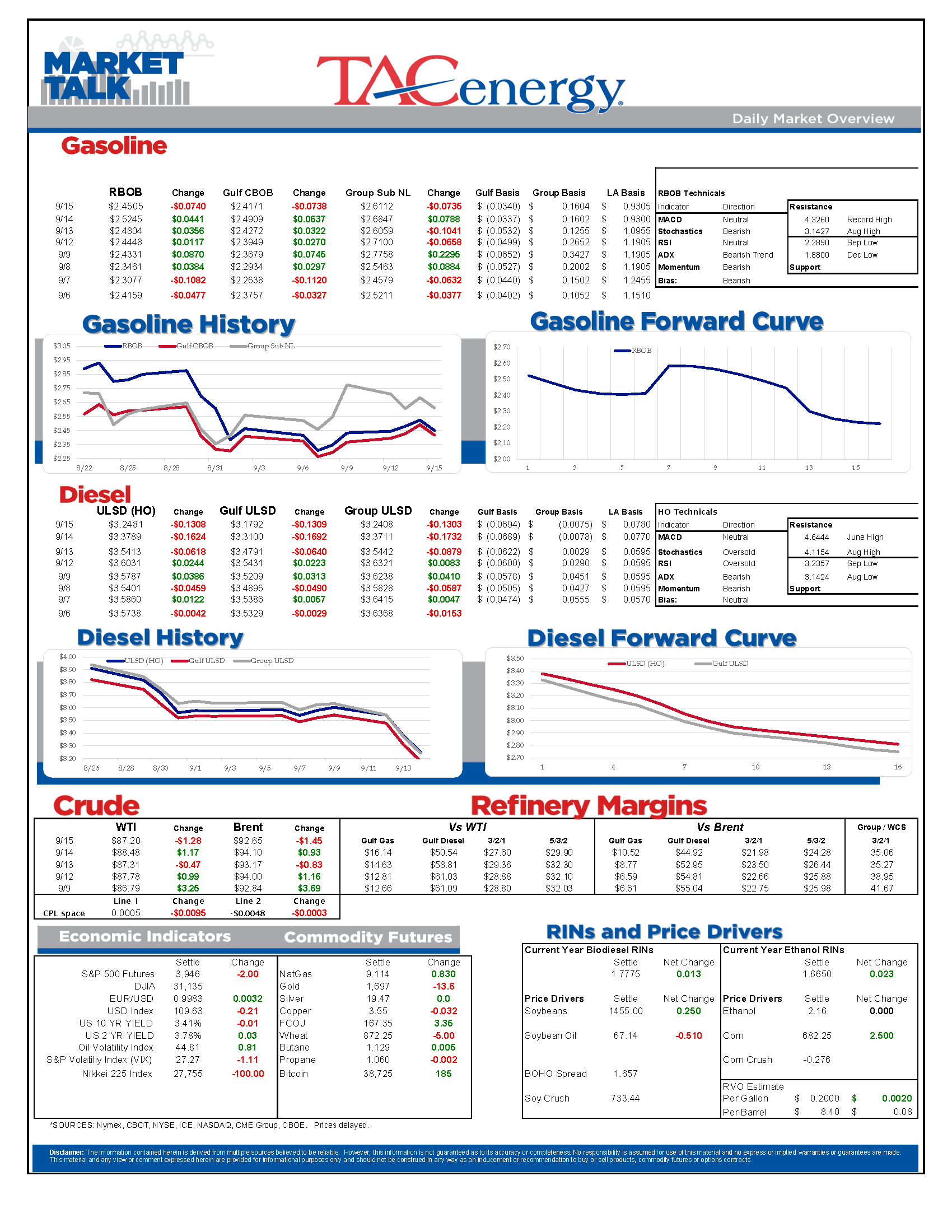Diesel Prices Have Dropped 45 Cents From Monday’s High

Diesel prices have dropped 45 cents from Monday’s high as demand concerns both domestically and globally are putting heavy downward pressure on prices, and RBOB and WTI are now joining in on the selling after resisting the pull lower Wednesday. ULSD futures are still more than 10 cents higher than their August lows, but look like they could make a run at those levels soon, with a move below $3 likely if that support breaks.
Some suppliers will be breathing easier this morning after reports that a “tentative deal” was reached to avert a nationwide railroad strike that could have created chaos in numerous commodity markets. Ethanol supplies in particular were troubling many suppliers this week as it could have left many terminals with plenty of gasoline in the tank, and yet no E10 available to sell at the rack, in addition to numerous concerns about Biodiesel and DEF supplies nationwide. Watch the price reaction in the grain, renewables and RIN markets today to see whether or not the market believes this deal will actually make it to reality.
The European Commission proposed an emergency energy market intervention plan Wednesday that includes mandatory reductions in demand for member countries, a cap on electricity prices from renewable, nuclear and coal sources, and a “temporary solidarity contribution on excess profits” for oil and gas sectors that somewhat like a Soviet-style solution to the Russian energy problem. The plan did not include a price cap on Russian energy purchases as had been previously proposed.
The IEA highlighted how Chinese lockdowns are leading a slump in global energy demand, but noted that demand is still growing, just not as fast as it was expected to this year. The monthly report also noted that EU embargos on Russian oil have not yet come into effect, and will do so just in time for the coordinated SPR releases to come to an end, leaving markets susceptible to new price spikes. The report highlights the specific concerns around distillate supplies, as Europe still does not have a solution for the 600mbday of Russian diesel it will stop importing this winter, and refinery capacity constraints severely limit their options.
Wednesday’s DOE report showed a large build in US Commercial crude inventories, but total oil stocks including the SPR declined, proving the IEA’s point that supplies may not look so strong once the record releases come to an end in two months. US crude oil output has stagnated over the past two months as labor logistical challenges continue to limit the growth in production. The report estimated that US diesel demand dropped by 13% to its lowest level of the year last week, which certainly isn’t helping encourage any buyers to step in at these lower levels, even though most PADDs have inventories well below normal levels.
Want to understand why California gasoline prices surged by more than $1/gallon last week? Take a look at the PADD 5 gasoline stocks chart below. Also note the huge decline in Midwestern (PADD 2) gasoline stocks the past 2 weeks as regional refiners have struggled to stay online, and shows how important the RVP waivers issues after BP’s refinery went offline were to avoid a price spike like we’ve seen on the West Coast.
Tropical storm Fiona was named overnight, and most models continue to suggest the storm will turn north by Monday and not threaten the Gulf of Mexico, making it a non-event for energy supplies. Most models keep this storm moving away from the East Coast as it moves north, but a few suggest that a landfall near the Carolinas is possible next week.
Latest Posts
Week 16 - US DOE Inventory Recap
Energy Markets Trading Quietly In The Red As Ethanol Prices Rally To Five-Month High
The Struggle For Renewable Producers Continues As A Rapid Influx Of Supply And Crashing Credit Prices Make Biodiesel
After Years Of Backwardation, Diesel Prices Have Slipped Into Contango Over The Past Week
Social Media
News & Views
View All
Week 16 - US DOE Inventory Recap

Energy Markets Trading Quietly In The Red As Ethanol Prices Rally To Five-Month High
Energy markets are trading quietly in the red to start Wednesday’s session after a healthy bounce Tuesday afternoon suggested the Israel-Iran-linked liquidation had finally run its course.
There are reports of more Ukrainian strikes on Russian energy assets overnight, but the sources are sketchy so far, and the market doesn’t seem to be reacting as if this is legitimate news.
Ethanol prices have rallied to a 5-month high this week as corn and other grain prices have rallied after the latest crop progress update highlighted risks to farmers this year, lower grain export expectations from Ukraine, and the approval of E15 blends this summer despite the fact it pollutes more. The rally in grain and renewables prices has also helped RIN values find a bid after it looked like they were about to test their 4-year lows last week.
The API reported small changes in refined product inventories last week, with gasoline stocks down about 600,000, while distillates were up 724,000. Crude oil inventories increased by 3.2 million barrels according to the industry-group estimates. The DOE’s weekly report is due out at its normal time this morning.
Total reported another upset at its Port Arthur refinery that’s been a frequent flier on the TCEQ alerts since the January deep freeze knocked it offline and damaged multiple operating units. This latest upset seems minor as the un-named unit impacted was returned to normal operations in under an hour. Gulf Coast basis markets have shrugged off most reports of refinery upsets this year as the region remains well supplied, and it’s unlikely we’ll see any impact from this news.
California conversely reacted in a big way to reports of an upset at Chevron’s El Segundo refinery outside of LA, with CARBOB basis values jumping by more than a dime. Energy News Today continued to show its value by reporting the upset before the flaring notice was even reported to area regulators, proving once again it’s ahead of the curve on refinery-related events. Another industry news outlet meanwhile struggled just to remember where the country’s largest diesel seller is located.
Click here to download a PDF of today's TACenergy Market Talk

The Struggle For Renewable Producers Continues As A Rapid Influx Of Supply And Crashing Credit Prices Make Biodiesel
The sigh of relief selloff continues in energy markets Tuesday morning, with gasoline prices now down more than 20 cents in 7 sessions, while diesel prices have dropped 26 cents in the past 12. Crude oil prices are within a few pennies of reaching a 1 month low as a lack of headlines from the world’s hot spots allows some reflection into the state of the world’s spare capacity for both oil and refined products.
Gasoline prices are trading near a 6-week low this morning, but still need to fall about another nickel in order to break the weekly trendline that pushed prices steadily higher since December. If that trend breaks, it will be safer to say that we saw the end of the spring gasoline rally on April 12th for the 2nd year in a row. Last year RBOB futures peaked on April 12 at $2.8943 and bottomed out on May 4th at $2.2500. The high (at this point) for this year was set on April 12th at $2.8516, and the low overnight was $2.6454.
It’s not just energy commodities that are seeing an unwind of the “flight to safety” trade: Gold prices had their biggest selloff in 2 years Monday and continue to point lower today. Just how much money poured into commodities in the weeks leading up to the direct confrontation between Israel and Iran is unclear, but we have seen in year’s past that these unwind-events can create a snowball effect as traders can be forced to sell to cover their margin calls.
Supply > Demand: The EIA this morning highlighted the record setting demand for natural gas in the US last year, which was not nearly enough to offset the glut of supply that forced prices to a record low in February. A shortage of natural gas in Europe was a key driver of the chaotic markets that smashed just about every record in 2022, and an excess of natural gas supply in Europe and the US this year is acting as a buffer, particularly on diesel prices.
The struggle for renewable producers continues as a rapid influx of supply and crashing credit prices make Biodiesel, RD and SAF unprofitable for many. In addition to the plant closures announced in the past 6 months, Vertex Energy reported Monday it’s operating its Renewable Diesel facility in Mobile AL at just 50% of capacity in Q1. The truly scary part for many is that the $1/gallon Blender's tax credit ends this year and is being replaced by the “Clean” Fuel production credit that forces producers to prove their emissions reductions in order to qualify for an increased subsidy. It’s impossible to say at this point how much the net reduction will be for domestic producers, but importers will get nothing, and at current CI values, many biodiesel producers may see their “blend credit” cut by more than half.
Click here to download a PDF of today's TACenergy Market Talk.

